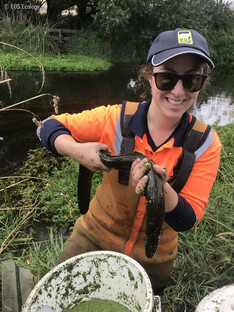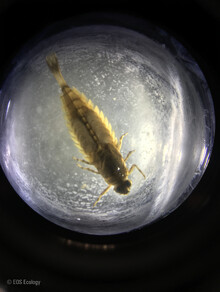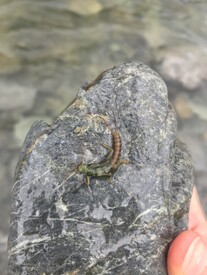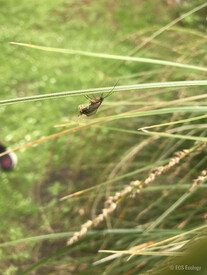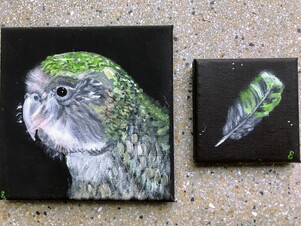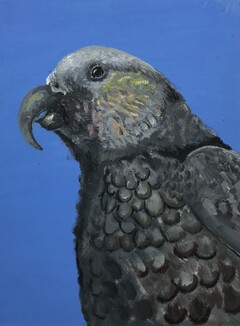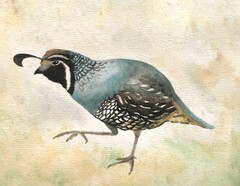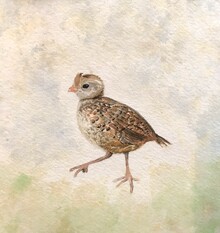Despite good intentions to write a blog and newsletter every month, my workload over the last few months has made it impossible. Having to shut my website and transfer the data to the online store, working on several urgent and very time-consuming projects and trying to push my wildlife illustration business to the next level has kept me flat-out busy (and this isn’t counting my tutoring commitments either).
FYI, if you search AuntieBettyIllustration.com, you will automatically be transferred to my online store, www.bumble-beesartandcrafts.com where you can now find my portfolio and other website information.
However, there is light at the end of the tunnel, and I am please to add, that several exciting development announcements will be made soon. So, watch this space!
To get back to our interview. I am so excited about today’s chat.
Emily is a good friend of mine.
Thank you, Emily, for your willingness to share your ecology and art journey with our readers. I have wanted to interview you for a long time, to share your love and knowledge of the tiny, water creatures that are invisible to the rest of us and so important for maintaining a healthy ecosystem.
Emily is a freshwater ecologist, with a love for New Zealand’s unsung microorganism heroes, which are fascinating and beautiful.
What is your background?
I did my academic studies at Massey University in Palmerston North, with an undergraduate in Ecology and Zoology, and an Honours in Ecology. I did my Honours thesis on freshwater macroinvertebrates (more on them later!).
What inspired you to become a biologist?
I think I have been on track to becoming a biologist for as long as I can remember! I have always had a strong interest in biology (particularly in animals), love being outdoors, and love being able to do practical, hands-on work. My interest in laboratory science was no doubt aided by having parents who are both biologists and educators. Much of my after-school time as a kid was spent at the university where my dad was a microbiology lecturer, and we were encouraged to be involved in whatever he was working on (a great learning opportunity for us, and free labour for my Dad!). When I discovered, during high school, that ecology was something you could actually study and get a job in, it didn’t take me long to make up my mind that it was what I wanted to do.
What inspires your work now?
As many people are becoming increasingly aware, protection of freshwater resources is a crucial issue, both from a conservation perspective but also from a human health and wellbeing perspective. To make good decisions about how to manage water, it is essential
to have good scientific data on the state that water ecosystems are in and understand the complicated combination of factors that affect these systems. It is my hope that the work I do will contribute to understanding this bigger picture and help with good decision-making for the future.
On a personal note, I am also inspired simply because I love the work that I do and am fortunate to be surrounded by colleagues that also love their work. I always get excited when I can talk to other people about the cool critters that I work with -- it reminds me how lucky I am to do the type of work that I have always wanted to do.
It is special when you can discuss with others what is important to you. They understand what makes you tick and share your enthusiasm. We can also trade ideas and help each other.
What does your job involve?
I am a freshwater ecology scientist, which means I study and report on the health of freshwater systems (mostly rivers and streams), am involved in giving advice about how to maintain or improve these ecosystems, and sometimes I get to be involved in the practical elements of protecting native species and improving the habitat that they live in. Our projects can involve a range of things, and I really enjoy the variety. On some days I might be wading in a river taking samples and measurements or catching fish or invertebrates. On other days I am in the laboratory identifying invertebrates under the microscope, or at the computer doing administration or writing reports.
What is your greatest challenge as a biologist?
I suppose one of the biggest challenges for ecologists is prioritising and finding ways of working on the most critical conservation issues with the limited time and resources available. As with many things, one of the major limitations is funding - someone must be willing to pay for a project for it to be made a reality! Another big challenge comes at the end of a project, and that is finding ways to clearly communicate scientific findings so that people understand and care about the results and change their behaviour in response.
If you were stranded on a desert island, and you could only take the most necessary equipment, what would it be?
A good net and a bucket to catch freshwater critters, and then some way of recording what I find.
I know what you mean. My dad is a mining engineer, who studied geology. The back seat of the car was always loaded with a variety of interesting rocks found on our holidays. He later became an Environmental Systems Manager and occasionally let us hang out with him while he was water testing. This is partly why I find your work so fascinating, because he loves the work you do.
What do you think are the greatest conservation needs in New Zealand?
I think habitat loss and degradation is one of the biggest issues in conservation in New Zealand (and worldwide). One of the key reasons that populations of so many species are declining is that there is a decreasing amount of suitable space for them to live, find food, and reproduce. In the freshwater ecosystems that I work in, habitat loss can happen in a range of ways, including drying of waterways caused by excess water consumption; building of dams, weirs, and other structures that block movement of fish upstream and downstream; removal of vegetation along riverbanks that animals rely on for shelter; pollution of waterways to the degree that they can no longer support sensitive wildlife; and draining of flowing waterways and wetlands to make space for human land use. There is an urgent need to stop further habitat loss and look at ways that we can restore degraded habitats.
Looking at it from the positive side, the advantage to focussing conservation efforts on protecting and restoring habitat is that it benefits an entire ecosystem and all the indigenous animals within it.
Which New Zealand creatures do you think need greater exposure?
Most of the animals that I work with are smaller and less glamorous than the bigger, cute, and/or cuddly animals that we are used to seeing in conservation media campaigns. For example, most native New Zealand freshwater fish are small, not particularly brightly coloured, and are mostly active at night-time. These characteristics can mean that they are overlooked when it comes to conservation efforts, and yet 76% of our native freshwater fish species are considered to be threatened or at risk of extinction.
Aside from our native fish, anyone who knows me well will know that my real soft spot is for freshwater macroinvertebrates. Invertebrates are animals without a backbone (like insects, snails, worms, etc.). There is a huge diversity of invertebrates that live in lakes, rivers and streams -- these are often referred to as freshwater “macro ”invertebrates, because they are invertebrates that are generally big enough to see with the naked eye (compared to “micro” invertebrates that are only visible under a microscope). Many freshwater macroinvertebrates are the larvae or nymphs (babies/juveniles) of flying insects like mayflies, stoneflies, midges, and dragonflies. There are also some freshwater invertebrates like water bugs, beetles, snails, and crustaceans that live their whole life cycle in the water.
Freshwater invertebrates are an important part of the food chain (the aquatic stages are eaten by fish, and the flying adult insects are also eaten by birds) and they help to break down plant material that falls into streams. They are also valuable to freshwater ecologists as indicator species -- we can look at what types of invertebrates are living in a particular place, and it gives us an indication of how healthy the stream is. I think most people would be surprised at how many different things are living in our rivers, and how interesting they all are!
What advice or tips can you give people interested in improving the chances of endangered species in New Zealand and around the world?
As I mentioned before, I think advocating for habitat protection and restoration is one of the key ways that people can help endangered species. First and foremost, this can mean speaking up against further habitat loss by whatever means are available to you. For example, if your local council has opened public consultation on any issue which will impact on at-risk species, take the opportunity to speak up.
Community groups can also provide a great opportunity to get involved with conservation issues in your local area. Well-established community groups will often have people with a great wealth of knowledge, and they can be an excellent tool for learning about issues that you are interested in.
If you are interested in pursuing ecology as a career -- absolutely go for it! Most people working in jobs like mine have some sort of tertiary qualification in ecology/zoology/environmental science, but I would strongly recommend making sure that you do your research into what kind of jobs a given degree will lead towards, as it might not always be what you think! In addition to getting a qualification, the most important thing you can do is seek out any opportunity you can to get practical experience. This might mean volunteering or getting summer work in an area that interests you. This will help you to figure out what kind of work you are most interested in and will also give you practical skills to make you stand out to future employers.
Finally, although it can seem like a bit of a cliche, there is a great deal of value in educating kids from as early an age as possible about our incredible wildlife and the importance of conservation. I think most kids have a fascination with some aspect of the natural world, and the more you can encourage and foster that with any kids in your life, the better!
Are you able to tell us about the project you are currently working on?
Working for a private consultancy, I tend to have lots of projects on the go at any given time. A few examples of the types of projects that we work on include long-term monitoring projects (in rivers, streams, and estuaries), AEEs (Assessments of Environmental Effects - looking at how a proposed human activity will impact the health of a waterway), and processing macroinvertebrate samples from waterways all over the country to identify the invertebrates living there as an indicator of how healthy the waterway is.
One slightly more unusual type of work that we do on a regular basis is fish relocation. When there is an activity (like construction in a waterway) that may impact on the fish, we are often called upon to temporarily move them out of harm’s way. We usually shift them to an area close by so that they can naturally swim back to the area that they came from when the work is finished, and temporary construction barriers are removed.
I also get to work with school kids as part of education and engagement programmes developed and run by the company that I work for. This usually involves taking kids down to their local stream and teaching them how to monitor stream health using the same types of methods that we as ecologists use in our own surveys. This empowers the kids to collect their own scientific data and participate in understanding and improving the health of their stream. Teaching the kids and seeing them get excited about what is living in their local streams is one of the great joys of my job.
What is your favourite endangered animal and why?
I would probably give a different answer every time I was asked this question because there are so many to choose from and I am always learning about new ones! In case I have not already made it clear, I have a bias towards invertebrates, and one problem for these little guys is that for many of them we still don’t have enough data to know which ones are endangered and which are not.
Some of my favourite invertebrates are the cased caddisflies, and there are some species of these in New Zealand that are endangered. Caddisflies are aquatic in their larval stage and are flying insects as adults. Fly fishermen will know caddisflies because they are commonly used as a model for fishing flies.
Cased caddisflies are really cool because they build themselves protective cases that they carry around with them (a bit like a snail or a hermit crab in that respect). These vary from straight cases to spiral cases (such as species in the genus Helicopsyche). Different species use different materials -- some use hollow sticks, while others spin cases out of a silky substance and cobble together tiny bits of plant material or stones into amazing mosaics! They will use all sorts of unusual materials too, depending on what is available to them. I have seen cases that have incorporated tiny snail shells, with the snails still living inside them (I do wonder how the snails feel about that!). I have also seen cases where an individual caddisfly has taken an empty case from a completely different species of caddisfly, and then made its own additions to the top end - like someone building an extension on a house. Sadly, we also sometimes find cases that include pieces of plastic rubbish, a sign of just one of many impacts humans are having on our waterways. I love caddisflies not only because they have such cool behaviour and are fantastic to look at, but they are also generally sensitive to degradation of streams; wherever we find them, it is a positive sign for the health of the stream.
You are also a talented painter. Are you painting anything now?
Thank you - that is quite a compliment coming from an incredible artist such as yourself! I have been dabbling a bit in watercolour painting recently, but I generally feel much more at home working with acrylics. My paintings are all wildlife-based, although no freshwater critters yet. As far as New Zealand species go, I have painted quite a few of our native birds. My most recent subject however was an introduced bird species, the California quail.
Do you have any other hobbies?
I love veggie gardening and bread baking, and I have been working on improving my sewing skills. I also enjoy dancing and rollerblading.
If we return to being stranded on a desert island, please share your favourite book, movie, food and music, if you could take these with you.
Book – ‘War and Peace’ because it is my favourite, and because at close to 600,000 words long it would give me plenty of reading material to keep me busy for a while!
Movie - Probably the original ‘Pirates of the Caribbean’. It has always been one of my favourites and seems appropriate to watch on a desert island.
Food - I am going to go with comfort foods - my dad’s falafel and my mum’s challah (a Jewish/Eastern European bread). And Rooibos tea. Lots and lots of tea!
Music - Bach’s cello suites, or almost anything by Josh Garrels.
Thank you for taking the time to chat with me today, and for sharing your fascinating work and beautiful paintings.
